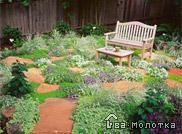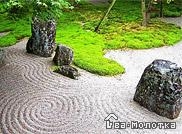Natural stone statues and fountains in exterior design

Natural stone sculptures
A sculpture in the garden is a landmark, an accent, something for which the eye catches a glimpse. Whereas a paved pathway creates colour, a natural stone sculpture embraces the spirit of the landscape.
They are mostly marble and granite that are used for creating small architectural forms, again with their excellent qualities in terms of colour rendering and resistance to temperature variations. What should be put into the garden? Sometimes the landscape is liable to be inhabited by characters from legends and myths, or by antique gods, or perhaps marble lions, dogs, snakes and lizards?

It all depends on your imagination and the purpose of the garden. A corner for active relaxation and a corner for quiet enjoyment will differ fundamentally, including the sculptures placed there.
Natural stone fountains
Water and stone are the most ancient combination of two seemingly so different matters. A fountain is meant to bring these two beginnings together.
The art of fountain creation dates back to ancient Greeks. It was them who first managed to combine the beauty of stone and pouring water. Fountains made of marble or granite, decorated with sculptures, can be the focal point of any garden or courtyard. It will undoubtedly attract attention, and reveal the taste of the owner.
There are different kinds of fountains:
– Indoor fountains. This is a special element of the interior which contributes to creating optimal humidity in the room.
– Running water. A kind of water structure, which is designed to imitate natural water bodies – springs, streams, water cascades. Running water is very popular in landscape design.
– Waterfalls. Artificially created waterfalls with the main emphasis on the effect of falling water.
– Classical fountains. Each model is based on a water composition framed by an appropriate architecture. Facing – granite, marble.
– Sculptural (architectural fountains). The main emphasis with such fountains is laid on sculpture. Water is an additional expressive element in such a fountain.
– Floating fountains. Decorate natural ponds, often serving to aerate standing water.
Dynamic (light-dynamic, musical) fountains. The top of fountain art that combines the beauty of classical fountains and technical possibilities – change of height and slope of the water jets, music and light background.
You have to be very careful when choosing a location for your fountain. It has an esthetic function and so does the function of the water feature. Never place your fountain directly under trees – falling leaves will contaminate the water and if the fountain has water plants, the biological balance would be poor. Tree roots could also damage the underground base of the fountain.
Source: www.dvamolotka.ru
